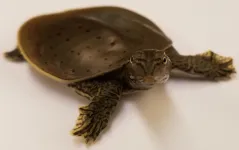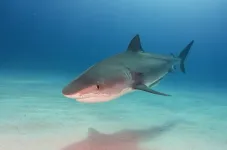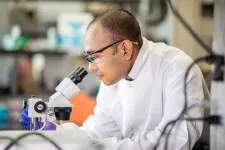(Press-News.org) Even in the absence of bark beetle outbreaks and wildfire, trees in Colorado subalpine forests are dying at increasing rates from warmer and drier summer conditions, found recent University of Colorado Boulder research.
The study, published in the May print issue of the Journal of Ecology, also found that this trend is increasing. In fact, tree mortality in subalpine Colorado forests not affected by fire or bark beetle outbreaks in the last decade has more than tripled since the 1980s.
"We have bark beetle outbreaks and wildfires that cause very obvious mortality of trees in Colorado. But we're showing that even in the areas that people go hiking in and where the forest looks healthy, mortality is increasing due to heat and dry conditions alone," said Robert Andrus, lead author of the study and postdoctoral researcher at Washington State University. "It's an early warning sign of climate change."
These deaths are not only affecting larger trees, thus reducing forests' carbon storage, but hotter and drier conditions are making it difficult for new trees to take root across the southern Rockies in Colorado, southern Wyoming and northern parts of New Mexico.
It's well known that rising temperatures and increasing drought are causing tree deaths in forests around the globe. But here in Colorado, researchers found that heat and drought alone are responsible for over 70% of tree deaths in the 13 areas of subalpine forest they measured over the past 37 years. That's compared with about 23% of tree deaths due to bark beetles and about 5% due to wind damage.
"It was really surprising to see how strong the relationship is between climate and tree mortality, to see that there was a very obvious effect of recent warmer and drier conditions on our subalpine forests," said Andrus, who conducted this research while completing his graduate degree in physical geography at CU Boulder. "The rate of increasing mortality is alarming."
With temperatures in Colorado having risen by about 2 degrees Fahrenheit since the 1980s and increasing more quickly at higher elevations, estimates of another possible 2.5 or more degrees of warming in the next few decades due to climate change indicate that the rate of tree deaths will only increase.
Seeing the forest for the trees
Subalpine forests cover over 10,000 square miles in Colorado and are best known by those who ski or recreate in the mountains. Subalpine fir and Engelmann spruce dominate the area above the Peak to Peak Highway in the Front Range, and if you go over any mountain pass in Colorado, you're going into the subalpine zone, according to Andrus.
Previous research at CU Boulder has shown how wildfire, beetle kill and the two combined can affect the mortality and health of Rocky Mountain subalpine forests. This new research isolated the effects of those two common stressors from those of heat and moisture to find out how much of an effect climate change is having on these tree populations.
"As trees die in increasing numbers due to fire, bark beetles and drought, the warmer and drier climate is making it much less likely that new tree seedlings can establish and replace the dead adult trees," said Tom Veblen, co-author of the study and professor emeritus of geography.
Launched by Veblen when he arrived on campus in 1982, this is the longest running study of tree mortality in Colorado with remeasurements made frequently enough to identify the factors causing tree death. Every three years since, graduate students, postdoctoral researchers and undergraduate field assistants have diligently returned to the more than 5,000 marked trees on Niwot Ridge just west of Boulder. In these 13 subalpine forest plots, they recorded that more trees died during summers with higher maximum temperatures and greater moisture deficits.
They found that tree mortality increased from .26% per year during 1982 to 1993, to .82% per year during 2008 to 2019--more than tripling within 40 years.
"It is really challenging because it's not very visually obvious to the casual observer," said Andrus. "But the thing to keep in mind is that while warmer, drier conditions are also causing more fire and bark beetle outbreaks, these slow and gradual changes are also important."
INFORMATION:
Additional authors on this publication include Rachel Chai of the Veblen Lab at CU Boulder; Brian Harvey, previously a postdoctoral researcher in geography at CU Boulder and now an assistant professor at the University of Washington; and Kyle Rodman, previously a graduate student in the Veblen Lab at CU Boulder and now a postdoctoral researcher at the University of Wisconsin Madison.
AMES, Iowa - A new study led by an Iowa State University scientist sheds light on how organisms have evolved to address imbalances in sex chromosomes.
The study looks at a species of softshell turtle, but the results could help to illuminate an important evolutionary process in many species, said Nicole Valenzuela, professor of ecology, evolution and organismal biology and lead author of the study.
Many organisms determine their sex by a pair of specialized chromosomes that appear in virtually every cell of an organism's body. A matched pair of chromosomes results in one sex, while a mismatched pair results in another sex. For instance, in humans and many other species, sex chromosomes are referred to as X and Y. Typically, two X chromosomes ...
Tokyo, Japan - Researchers from Tokyo Metropolitan University have developed a new technology which allows non-contact manipulation of small objects using sound waves. They used a hemispherical array of ultrasound transducers to generate a 3D acoustic fields which stably trapped and lifted a small polystyrene ball from a reflective surface. Although their technique employs a method similar to laser trapping in biology, adaptable to a wider range of particle sizes and materials.
The ability to move objects without touching them might sound like magic, but in the world of ...
At a glance:
Researchers studied cells collected by nasal swabs at the moment of diagnosis for both mild and severe COVID-19 patients
Cells taken from patients who went on to develop severe disease had a muted antiviral response compared to those who went on to develop mild disease
This suggests that it may be possible to develop early interventions that prevent severe COVID-19 from developing
The team also identified infected host cells and pathways associated with protection against infection that may enable new therapeutic strategies for COVID-19 and other respiratory viral infections
CAMBRIDGE, MA (July 23, 2021) -- Over the past 18 ...
St. Jude Children's Research Hospital investigators have demonstrated that comprehensive genomic sequencing of all pediatric cancer patients is feasible and essential to capitalize on the lifesaving potential of precision medicine. Results from the St. Jude Genomes for Kids study appear online today in the journal Cancer Discovery.
Whole genome and whole exome sequencing of germline DNA was offered to all 309 patients who enrolled in the study. Whole genome, whole exome and RNA sequencing of tumor DNA was carried out for the 253 patients for whom adequate tumor samples were available.
Overall, 86% of patients had at least one ...
MEADVILLE, PA - July 22, 2021 - Shark Week is many things. First and foremost, it's a week of shark-themed documentary programming on the Discovery Channel. Now in its 33rd year, it's the longest-running cable event in history. It's the biggest audience that marine biologists and ocean conservationists get, attracting millions of viewers who might otherwise not ever think about sharks at all. It's a stage that has launched careers of shark scientists and inspired many others to pursue jobs as ocean scientists.
However, a new analysis shows that Shark Week is also deeply flawed in ways that undermine its goals, potentially harming both sharks and shark scientists. To document just how pervasive ...
Toronto -- People post 500 million tweets and 4 billion pieces of content on Facebook a day. What makes them do it?
An urge to share and connect with others seems obvious. But, despite how toxic the social media sandbox can get, people more often share attitudes that are framed in terms of support instead of opposition, according to new research. That happens regardless of whether the opinion itself is positive or negative.
Take gun control. The research found that people were likelier to express themselves on that issue in terms of, "I support allowing guns," or, "I support banning guns," versus, "I oppose banning guns," or, "I oppose allowing guns."
"There are a lot of controversial issues where both sides talk about what they support - pro-life and pro-choice on abortion, for example," ...
Recently, a research group led by Prof. YUAN Kaijun and Prof. YANG Xueming from the Dalian Institute of Chemical Physics (DICP) of the Chinese Academy of Sciences revealed strong isotope effects in photodissociation of the water isotopologue (HOD) using the Dalian Coherent Light Source.
Their findings were published in Science Advances on July 23.
"Our experimental results illustrate dramatically different quantum state population distributions of OH and OD fragments from HOD photodissociation. The branching ratios of the H+OD and D+OH channels display large wavelength-dependent isotopic fractionation," said Prof. YUAN.
Because ...
Research in mice, published today in Science Immunology by researchers at the Babraham Institute, UK and VIB-KU Leuven, Belgium, provides two solutions with potential to overcome a key clinical limitation of immune cell therapies. Regulatory T cells have potential in treating autoimmunity and inflammatory diseases yet they can switch from a protective to damaging function. By identifying the unstable regulatory T cells, and understanding how they can be purged from a cell population, the authors highlight a path forward for regulatory T cell transfer therapy.
Cell therapy is based on purifying cells from a patient, growing them up in cell culture to improve their properties, and then reinfusing them into the patient. Professor Adrian ...
In the evolving field of cancer biology and treatment, innovations in organ-on-a-chip microdevices allow researchers to discover more about the disease outside the human body. These organs-on-chips serve as a model of the state an actual cancer patient is in, thus allowing an opportunity to finding the correct treatment before administering it to the patient. At Texas A&M University, researchers are pushing these devices to new levels that could change the way clinicians approach cancer treatment, particularly ovarian cancer.
The team has recently submitted a patent disclosure with the Texas A&M Engineering Experiment Station.
"We claim several novelties in technological ...
A study by researchers at the Texas A&M University School of Public Health shows that inexpensive and convenient devices such as silicone wristbands can be used to yield quantitative air quality data, which is particularly appealing for periods of susceptibility such as pregnancy.
The research team found that the wristbands, when used as passive samplers, have the ability to bind smaller molecular weight semi-volatile polycyclic aromatic hydrocarbons (PAHs) -- a class of chemicals that occur naturally in coal, crude oil and gasoline and are produced when coal, oil, gas, wood, garbage and tobacco are burned -- in a similar pattern as active sampling.
Published recently in Nature's ...






